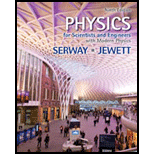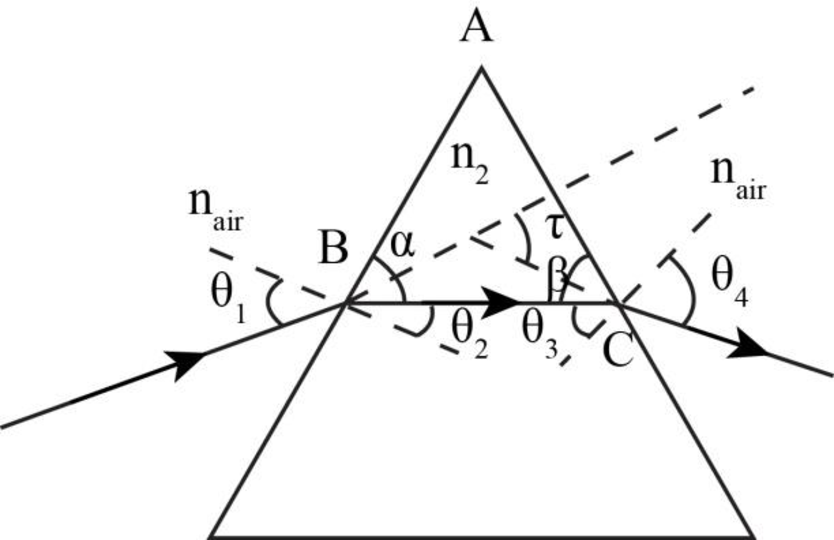
(a)
The angle of refraction at the first surface.
(a)
Answer to Problem 29P
The angle of refraction at the first surface is
Explanation of Solution

Figure-(1)
Write the expression of Snell`s Law.
Here,
Conclusion:
Substitute
Therefore, the angle of refraction at the first surface is
(b)
The angle of incidence at the second surface.
(b)
Answer to Problem 29P
The angle of incidence at the second surface is
Explanation of Solution
From the figure-(1)
Here
Add equation (III) and (IV).
From the figure in
Conclusion:
Substitute equation (V) in equation (IV)
Substitute
Therefore, the angle of incidence at the second surface is
(c)
The angle of refraction at the second surface.
(c)
Answer to Problem 29P
The angle of refraction at the second surface is
Explanation of Solution
Write the expression of Snell`s Law.
Here,
Conclusion:
Substitute
Therefore, the angle of refraction at the second surface is
(d)
The angle between the incident rays and emerging rays.
(d)
Answer to Problem 29P
The angle between the incident and emerging rays is
Explanation of Solution
Write the expression of angle between incident and emerging rays.
Here,
Conclusion:
Substitute
Therefore, the angle between the incident and emerging rays is
Want to see more full solutions like this?
Chapter 35 Solutions
Physics for Scientists and Engineers With Modern Physics
- A ray of light strikes a flat, 2.00-cm-thick block of glass (n = 1.50) at ail angle of 30.0 with respect to the normal (Fig. P22.18). (a) Find the angle of refraction at the lop surface. (b) Find the angle of incidence at the bottom surface and the refracted angle. (c) Find the lateral distance d by which the light beam is shifted. (d) Calculate the speed of light in the glass and (e) the time required for the light to pass through the glass block. (f) Is the travel time through the block affected by the angle of incidence? Explain.arrow_forwardLight traveling in a medium of index of refraction n1 is incident on another medium having an index of refraction n2. Under which of the following conditions can total internal reflection occur at the interface of the two media? (a) The indices of refraction have the relation n2 n1. (b) The indices of refraction have the relation n1 n2. (c) Light travels slower in the second medium than in the first. (d) The angle of incidence is less than the critical angle. (e) The angle of incidence must equal the angle of refraction.arrow_forwardLight of wavelength 700 nm is incident on the face of a diamond prism at room temperature of 20 °C and an incidence angle of 75.0°. The apex angle of the prism is 60.0°. Calculate the angle (a) of refraction at the first surface (b) of incidence at the second surface (c) of refraction at the second surface (d) between the incident and emerging rays.arrow_forward
- A ray of light is incident on a glass prism (n = 1.5) with an angle of incidence 0. This ray emerges from the opposite side of the prism with an angle 03 = 22.3°. The apex angle of the prism is = 50° and the deviation angle between the incident ray and the emerging ray is 8 = 32.3°. The angle of refraction at the first surface of the prism, 0,, equals to n =1.5 O 50.2° O 35.3° 60.0° O 14.7°arrow_forwardA ray of light is incident on a glass prism (n = 1.5) with an angle of incidence 0, = 40°. The ray emerges from the opposite side of the prism with an angle 04. The apex angle of the prism is 60°. The deviation angle, 8, between the incident ray and the emerging ray is then: 60° 0, = 40° Nair =1 38.4° O 51.3° O 21.7° 44.5° 13.8°arrow_forwardA ray of light enters parallel to the axis of a hollow cylindrical tube. When the tube has only air, the light takes 18.6 ns to travel the full length of the cylinder, but when the tube is filled with a transparent substance, it takes 7.1 ns longer to travel by comparison. What is the refractive incidence of that substance?arrow_forward
- A beam of light is propagating through a diamond (n1= 2.42) and strikes a diamond- air interface at an angle of incidence of 30°. (a) Will part of the beam enter the air (n2 = 1.00) or will the beam be totally reflected at the interface? (b) Repeat part (a), assuming that the diamond is surrounded by water (n2= 1.33) instead of air.arrow_forwardA light ray traveling in air strikes the surface of a slab of glass at an angle of incidence of 50°, Part of the light is reflected and part is refracted.. Find the angle the refracted ray makes with respect to the normal to the airiglass interface. For the toolbar, press ALT+F10 (PC) or ALT+FN+F10 (Mac). B IUS Paragraph Arial 10pt * G自Q x X, ४ ४ + ABC 田 日田田国 Í (1} © © O OWORDS POWERED BY TINY Sve All Answers Speand Submit 7 AM Click Save and Submit to save and submit, Click Save All Answers to save all answers. R. W 田 国arrow_forwardIn the figure, light is incident at angle 6, = 41.0° on a boundary between two transparent materials. Some of the light travels down through the next three layers of transparent materials, while some of it reflects upward and then escapes into the air. If n1 = 1.28, n, = 1.38, ng = 1.30 and n4 = 1.43, what is the value of (a) 05 and (b) 04? Air (a) 05 = NumberT32.02 UnitsTo (degrees) (b)04 = NumberT43.1 Units (degrees)arrow_forward
- Light, when incident on a given surface, presents a reflected and a refracted component. When the reflected beam is perpendicular to the refracted beam, the angle of incidence θᵢ is called Brewster's angle. If a beam of light is initially in air with index of refraction n₁ = 1 and is incident on a glass surface (index of refraction n₂ = 1.5), Brewster's angle is: a)82.9° b)36.3° c)75.4° d)62.9° e)56.3° f)45.7°arrow_forwardK A light ray with a wavelength of 589 nanometers (produced by a sodium lamp) traveling through air makes an angle of = to find the angle of refraction, V2 sin 0₁ V₁ y incidence of 55° on a smooth, flat slab of dense flint glass. Use Snell's Law, sin 02 where the index of refraction is 1.66. ... The angle of refraction is approximately degrees. (Type an integer or decimal rounded to two decimal places as needed.)arrow_forwardLight of wavelength 471 nm is incident on the face of a silica prism at an angle of θ1 = 75◦ (with respect to the normal to the surface). The apex angle of the prism is φ = 57.5◦. Given: The value of the index of refraction for silica is n = 1.455. Find the angle of refraction at this first surface. Answer in units of degrees. Find the angle of incidence at the second surface. Answer in units of degrees. Find the angle of refraction at the second surface. Answer in units of degrees. Find the angle between the incident and emerging rays. Answer in units of degrees.arrow_forward
 Principles of Physics: A Calculus-Based TextPhysicsISBN:9781133104261Author:Raymond A. Serway, John W. JewettPublisher:Cengage Learning
Principles of Physics: A Calculus-Based TextPhysicsISBN:9781133104261Author:Raymond A. Serway, John W. JewettPublisher:Cengage Learning Physics for Scientists and Engineers with Modern ...PhysicsISBN:9781337553292Author:Raymond A. Serway, John W. JewettPublisher:Cengage Learning
Physics for Scientists and Engineers with Modern ...PhysicsISBN:9781337553292Author:Raymond A. Serway, John W. JewettPublisher:Cengage Learning Physics for Scientists and EngineersPhysicsISBN:9781337553278Author:Raymond A. Serway, John W. JewettPublisher:Cengage Learning
Physics for Scientists and EngineersPhysicsISBN:9781337553278Author:Raymond A. Serway, John W. JewettPublisher:Cengage Learning College PhysicsPhysicsISBN:9781305952300Author:Raymond A. Serway, Chris VuillePublisher:Cengage Learning
College PhysicsPhysicsISBN:9781305952300Author:Raymond A. Serway, Chris VuillePublisher:Cengage Learning



